What do Panasonic & Daikin offer?
Long story short, Panasonic and Daikin are not cheap brands of air conditioners by any stretch, but they are leaders in advanced cooling and air purification. They also specialise in split system air conditioners with most reverse cycle units to also have you covered in winter. Let’s dig into what these two giants of cooling have to offer, broken down by power and price:
| Price Bracket | Model | Priced From |
|---|---|---|
| Under $1,000 | Panasonic U Series (2.5kW) Cooling Only Split System | $929* |
| Daikin Cora (2.5kW) Split System | $979* | |
| Under $1,500 | Panasonic Z XKR Series (3.5kW/4.0kW) Reverse Cycle Split System | $1,399* |
| Daikin Zena (3.5kW) Split System | $1,430* | |
| Under $2,000 | Panasonic AERO Series (7.1kW) Premium Reverse Cycle Split System | $1,995* |
| Daikin Alira X (7.1kW) Split System | $1,999* | |
| Under $3,000 | Panasonic Z XKR Series (8.0kW/9.0kW) Wi-Fi Reverse Cycle Split System | $2,799* |
| Daikin XL Series (9.4kW) Split System | $2,920* |
*Prices taken from respective retailers and Appliances Online, correct as of October 2022.
Daikin vs Panasonic air conditioners under $1,000
While not strictly in the ‘budget’ category, these are some of the cheapest air conditioners among Panasonic’s and Daikin’s ranges. Remember, they are not the cheapest – their value is in their quality.
Panasonic
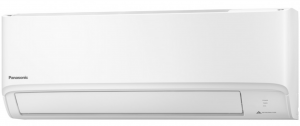
The Panasonic U Series (2.5kW) Cooling Only Split System is one of the cheapest models from the brand and a practical choice for households who want a no-frills cooling unit that gets the job done without guzzling power. Its hero feature is the intelligent ECO Mode with AI Control that allows the AC unit to efficiently cool rooms based on heat load and energy usage. It offers optimal airflow thanks to its AEROWINGS setup, a Powerful Mode for speedy cooling, and anti-corrosion Blue Fin technology on the outdoor unit.
Daikin
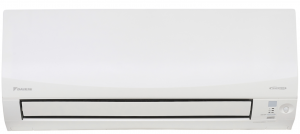
In this price bracket, Daikin offers more than Panasonic. The Daikin Cora (2.5kW) Split System features an Intelligent Eye human sensor that ensures draught-free cooling for people in each room and turns the unit off when it’s unoccupied. It also offers Coanda Airflow to stream air along the ceiling for effective cooling, precision control with temperatures set in 0.5°C increments, an enzyme blue air purification system and a Powerful button to you give you a boost in cooling or heating power for a 20-minute period
Daikin vs Panasonic air conditioners under $1,500
If you’re willing to part with some more of your pennies, then you might be surprised at the value that’s on offer for a touch over $1,000 among the two brands.
Panasonic
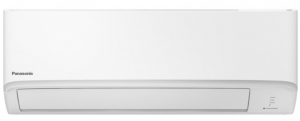
Representing a good mid-range option, the Panasonic Z XKR Series (3.5kW/4.0kW) Reverse Cycle Split System features multiple operating modes, an energy-efficient cooling setup, and an advanced air purification system. The brand’s Nanoe X air purification system not only deodorises the air but also removes airborne particles and allergens, and prevents the growth of bacteria, viruses, pollen, and mould. It also offers smart connectivity via the Comfort Cloud app with a built-in Wi-Fi function to control your AC from anywhere, and voice assistance with Google Assistant and Amazon Alexa.
Daikin
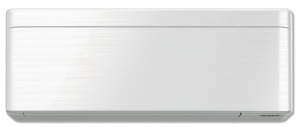
The Daikin Zena (3.5kW) Split System is ideal for air conditioning in a single room or area. It features built-in WiFi connectivity, so you can control timers and temperatures from your smartphone, infrared human presence sensors, Coanda Airflow which directs the cool air and cools from the top down, which is known as the Coanda Effect, and vertical airflow with louvers that stream heated air down the wall and towards the floor. Further, its precise temperature controls of 0.5°C mean that you can nail down your desired temperature with ease. This is a good option for those looking for a feature-packed mid-range air conditioner.
Daikin vs Panasonic air conditioners under $2,000
If your budget can stretch to the upper echelons of split-system air-conditioned glory, then we suspect you’ll be pretty happy with either the Panasonic or Daikin models here.
Panasonic

A significant step up from the previous models mentioned, the Panasonic AERO Series (7.1kW) Premium Reverse Cycle Split System is ideal for maintaining air quality and the ideal temperature inside your home. This model comes with multiple operating modes, the brand’s signature Nanoe X air purification technology, iAUTO-X technology for optimum cooling and energy efficiency, Wi-Fi connectivity via the Panasonic Comfort Cloud app, and support with Google Assistant and Amazon Alexa.
Daikin
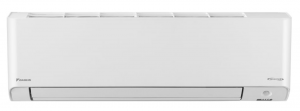
For about the same price as the Panasonic above, the Daikin Alira X (7.1kW) Split System features Coanda Airflow, as well as 2-Area Intelligent Eye. It also features three layers of filtration, including a pre-filter for large particulates, an enzyme blue deodorising filter for odours, and Daikin’s Streamer technology for powerful oxidative decomposition of pollutants. This model is approved under the Sensitive Choice Program by the National Asthma Council Australia. Other key features include built-in Wi-Fi, Coanda Airflow, and multiple controls for quiet operation, dry and eco mode, etc.
Daikin vs Panasonic air conditioners under $3,000
At the higher end of the spectrum, both Daikin and Panasonic pack a punch in full-bore cooling – and heating – power.
Panasonic

The Panasonic Z XKR Series (8.0kW/9.0kW) Wi-Fi Reverse Cycle Split System is suitable for larger rooms and likely capable of handling a family’s needs. It features multiple operating modes (including timers, eco and whisper quiet), good energy efficiency, advanced air purification with Nanoe X technology, and smart connectivity via the Comfort Cloud app. The Panasonic Z XKR Series range also comes with a compact and modern design, making it a great fit for any home.
Daikin

As one of the more high-end units in Daikin’s lineup, the XL Series (9.4kW) Split System has a sensational power level and is sure to make light work of your family’s cooling needs. What’s also impressive, is that it all operates at 54 decibels, and in relation to its XL size and power, is a noteworthy achievement. The XL Series range features a combination of vertical and horizontal auto swing louvers to circulate air more effectively in larger rooms, intelligent infrared human presence sensors, enzyme blue deodorising air purification, and more.
Panasonic vs Daikin: Technology & features compared
Moving on from the model comparison, which we hope has proved useful, the next step in determining who is the king of air conditioning is to compare the technology and features generally found in each brand’s models. Both are high-end brands in the cooling world, but how do their key features and trademark technology compare?
Smart cooling

What makes these brands the best at what they do is their super smart air conditioning technology, which is constantly evolving and leaving the other big brands behind. While the technology is similar in many ways, there are contrasting features to each product range, which can make a huge difference to the buyer. Both brands offer a human sensor control that detects when someone is actually in the room and will adjust automatically to save on energy. Daikin’s 2-Area intelligent eye will automatically detect when you leave and enter the room. If the room is empty for 20 minutes, it will adjust to an energy-saving setting and then return to its original setting when someone re-enters the room.
In comparison, Panasonic’s technology is arguably more advanced. It will not only detect when someone leaves or enters a room but will adjust the flow of air to the area of human activity. It will also adjust the cooling temperature when it detects changes in the sunlight intensity of the room. You can’t really go wrong with either brand when it comes to smart cooling, but Panasonic may have the slight edge here as it goes one further. This may also be a reflection of the brand’s general higher price compared to Daikin.
Air purification capabilities
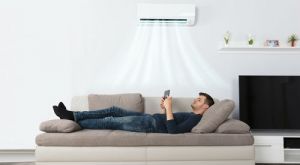
Both the Panasonic and Daikin models offer an air purifying function to keep the air clean and healthy. Panasonic’s Nanoe X uses nanotechnology which works on micro-organisms, such as bacteria and viruses, to provide a cleaner living environment. It claims to remove up to 99% of bacteria and viruses and will deactivate any bacteria which have been trapped in the filter. Panasonic’s Nanoe X split system air conditioners are approved for the Sensitive Choice program.
On par, Daikin’s air purifying filtration systems have also been rewarded by The National Asthma Council with a Sensitive Choice symbol. Another winning feature in the Daikin range is an automatic self-cleaning filter which removes dust to maintain the airflow and reduce power consumption. It’s pretty even here, but we’d give Daikin the edge for its NAC certification. While both brands would likely be good contenders for the allergy-prone, the fact that Daikin has this certification means that it’s a winner in this regard.
Control power
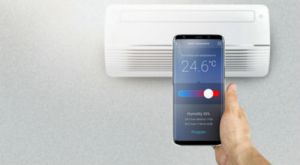
With the advanced technology of their smartphone-controlled systems, both Daikin and Panasonic are top competitors in the air conditioning world. Having access to technology at our fingertips is part and parcel of the modern-day, so when a brand can offer smartphone technology on its products, it’s a huge selling point to consumers. The technology allows you to monitor and control your system from anywhere – as long as you have an internet connection at home and on your phone or tablet. You can turn your air conditioner on and adjust the temperature of your home before you even get there. In terms of accessibility, it seems Panasonic has smartphone features included in the price and with a wider variety of models and price points; for this alone, we’ll hand this section to Panasonic.
Daikin vs Panasonic air conditioners: Who’s the winner?
The Panasonic and Daikin product ranges both offer advanced technology and are super-energy efficient, so when they are pitted against each other it’s extremely tough to award a champion. Barring sales, Panasonic found itself to be the slightly more expensive of the two brands, and this was found in its generally more impressive list of features across a range of models.
With the two pitted against each other, however, we suspect it’ll come down to your own individual budget versus technology desires. You might like to check out Canstar Blue’s customer satisfaction ratings for air conditioners, to see how each brand was rated by Aussie consumers.
Original Author: Tahnee-Jae Lopez-Vito




Share this article